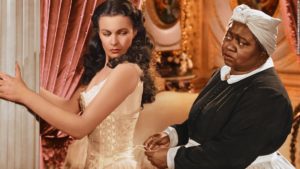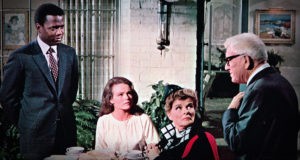In the wake of the Black Lives Matter protests around the country and across the globe, HBO Max announced earlier this summer that it was pulling the historical epic Gone with the Wind (1939) from the streaming lineup. Then it returned to the lineup with a scholar of African American studies introducing it and offering essential context.
As with recent controversies about Civil War memorials and statues, military base names and Rebel flags, and changes in consumer product lines or images, a predictable number of politicians and pundits cried censorship or lamented that their history and heritage are being stolen. White House press secretary Kayleigh McEnany snorted her disbelief that anyone could find Gone with the Wind offensive. But as someone who has been teaching American film and literature for decades, and who for the past four years has been publicly screening films on race and prejudice in houses of worship, I can tell you that HBO’s approach is exactly how we should introduce challenging texts if we are hoping for recognition and repentance.
“HBO’s approach is exactly how we should introduce challenging texts if we are hoping for recognition and repentance.”
Films (like all stories) carry mythologies. Some of those myths are empathetic and humane, some are soul-killing, but after we identify and contextualize those myths, we can enter into good hard conversations about them and what they have to say about racism in America. Stories give us that gift of talking about characters and situations, not about ourselves and our own entrenched positions. Compare the conversations you may have had about a great novel with simply leaning in and launching a controversial opinion at your family’s Thanksgiving dinner and you’ll see what I mean.
Spike Lee opens his film BlackKklansman (2018) with a notable scene from Gone with the Wind. As Scarlett O’Hara (Vivien Leigh) picks her way through thousands of wounded Confederate soldiers in the Atlanta railyards, the camera rises a hundred feet in the air, offering the panoramic spectacle of manly suffering on a mammoth scale. The martial music swells, and the shot finally encompasses a Rebel battle flag, flapping in the breeze.
It’s a powerful shot from one of the most powerful narratives of the Southern Lost Cause, and if we want to identify dangerous myths in Gone with the Wind, this is the place to start. Like towering statues of Southern heroes erected in the early 20th century, like the monuments erected at courthouses and state capitols as remembrances of the Southern Way of Life, Gone with the Wind argues that the South’s defeat in the Civil War was a tragedy. Chivalrous men, graceful women and contented slaves lost a noble civilization that far surpassed that of the money-grubbing North.

Vivien Leigh and Hattie McDaniel in “Gone with the Wind.”
Gone with the Wind shows us every offensive racial stereotype on offer as part of its defense of the Lost Cause. Blacks are childish, or lazy, or brutish, and so must be kept in their place by wise and paternal whites. Hattie McDaniel’s Mammy is “like one of the family,” a loyal servant whose existence revolves around her masters. It is to McDaniel’s credit that the role — which won her the first Academy Award ever given an African American actor — partakes of humanity as well as of those searing stereotypes.
But drawing attention to Gone with the Wind’s stereotypes and historical issues is not censoring it; it is placing those things within a framework that allows us to better appreciate and comprehend the work itself. I talk often about the cinematic power of D.W. Griffith’s racist masterwork The Birth of A Nation (1915). One can hold, at the same time, the idea that a film is a notable achievement, and on the other, that the ideas it expresses are dated, offensive or repressive.
We screened Guess Who’s Coming to Dinner (1967) a few years back, at the annual Long, Long Way Film Festival at Washington National Cathedral. Fifty years after its release, that movie at first feels somewhat dated, and its depiction of Dr. John Prentiss (Sidney Poitier) as the Black suitor of a white woman, Joey Drayton (Katharine Houghton), was ridiculed by James Baldwin, who called the perfect Prentiss “the Wonder Doctor.” Where are his depth, his flaws, his complete humanity?

Sidney Portier (left) in “Guess Who’s Coming to Dinner.”
But a proper contextualization of that film allows us to realize and respect how radical it was for its time. Poitier’s character may be essentially flawless, but his nobility, intelligence and dignity stand in startling contrast to generations of Coons, Bucks, Mammies and Uncle Toms. While the film was in production, mixed-race marriages were illegal in a third of American states. And even though Spencer Tracy’s Matt Drayton, struggling with whether to grant the couple his blessing, is undeniably a Great White Father with ultimate control over Dr. Prentiss’ life, his struggle offers something to us today.
Matt Drayton is a good American liberal, theoretically on the right side of racial issues. But this — this is personal, and Tracy, whose on-screen persona partook of innate decency, could stand in for any white viewers who might fear how personal engagement with racial questions might complicate their lives in ways they hadn’t foreseen. He could dramatically model the hard work — and affirm for audience members that it was worth doing.
“One can hold, at the same time, the idea that a film is a notable achievement, and on the other, that the ideas it expresses are dated, offensive or repressive.”
So it is with most texts. Some understanding of when it was composed, how the original audience received it, what type of story it is, what its author intended to accomplish, and how we might necessarily view or read or hear it differently in 2020, is essential if we are to consume it thoughtfully and learn what it has to teach us or warn us about our humanity and our lives together.
Whether we’re drawing attention to the White Savior myth in Glory (1989), or Get Out’s (2017) reversal of common horror film tropes, whether we’re learning about the 1921 massacre of African Americans in Tulsa’s Greenwood district in HBO’s multi-Emmy-nominated Watchmen (2019) or learning about how the 1986 Howard Beach incident sparked Spike Lee’s Do the Right Thing (1989), context is a necessary thing. It lets us mourn the bad ideas, celebrate the good and enter into conversation about these stories with eyes wide open. Only so can we move forward into the work of repair and reconciliation.
 Greg Garrett is professor of English at Baylor University, theologian in residence at the American Cathedral in Paris, and author of two dozen books, among them the new A Long, Long Way: Hollywood’s Unfinished Journey from Racism to Reconciliation.
Greg Garrett is professor of English at Baylor University, theologian in residence at the American Cathedral in Paris, and author of two dozen books, among them the new A Long, Long Way: Hollywood’s Unfinished Journey from Racism to Reconciliation.
More by Greg Garrett:
What kind of witness will the white Christian church give?
‘OK, we live in a racist society. What do we do next?’

